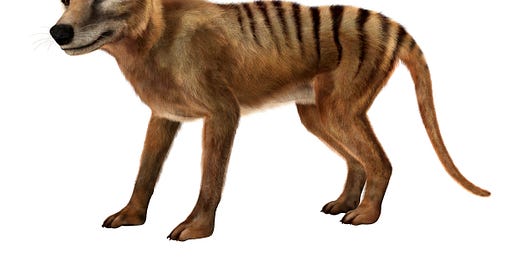The week began with that lurid, sickly-sweet feeling, the feeling of eating cotton candy in the hot sun all day and now the sun is setting and you’re on a roller coaster and it’s going higher and higher very very slowly and it’s still very hot and humid out and you don’t want to be a naysayer because you know this is supposed to be fun but something tells you this isn’t going to end well.
I am speaking of the announcement by Neil Waters, the president of the Thylacine Awareness Group of Australia, that he possessed evidence of a family of living Tasmanian tigers, or thylacines.
Thyacines have been officially extinct since the 1930’s, though there have been any number of sightings in Tasmania and even mainland Australia since then. Earlier sightings may well have been holdouts from a small population under assault; later sightings are much more likely to be some combination of mistaken identities, fraudsters, and the hauntings of guilty imaginations.
A thylacine:
Source: iStock
Waters was sending his camera trap evidence to the Tasmanian Museum and Art Gallery for analysis, and he acknowledged that the mum and dad were a little hard to make out — but the baby! The baby had stripes and a stiff tail.
The New Yorker looked into thylacine sightings a few years ago. Thylacines seem to have a way of catching their admirers by the tail, making fanatics of their fans. One interviewee in the New Yorker story had lost his wife over the hobby.
By mid-week, when the Tasmanian Museum and Art Gallery announced that the footage likely showed a pademelon instead of a thylacine, buzz over the story had exploded. Waters continues to insist that the baby, at least, is a thylacine.
A pademelon:
Source: J.J. Harrison, Wikimedia Commons
Meanwhile, another and opposite extinction story was playing out in Borneo: a small, and to me, somewhat unremarkable-looking bird had been discovered again, 180 years after its last sighting. The black-browed babbler had long been thought extinct. Conservationists hope to learn more as soon as COVID-19 restrictions are lifted.
The two stories reminded me a little of landing in the north of Kenya, expecting one thing, getting something else, and how hard it was to see the something else once you got it.
What I expected — what I came for — which was completely reasonable, as it’s what everyone comes for — was the alien life forms, the animals that have been shaped by dryness and mountains into elegant yet absurd living sculptures.
There’s the antelope with a stalk for a neck and a tiny head on top, almost all eye, so that the effect is of some kind of land-based, mammalian periscope peering over the bushes some distance away.
There’s the giraffe that has given itself over to cold, hard arithmetic — not for it the expressionistic splotches of that inferior species, the Masai giraffe, no! The reticulated giraffe has it all figured out, using only the most pleasing geometric shapes, only the most even of spacing.
I had come for these creatures and I did see them but, perhaps even more amazing than these were the crickets. Locusts, when gathered in strength. Which they were.
At the time, of course, they were a nuisance.
Here, in Kenya’s dry center, where they sing water lullabies to their cows to draw them to their wells, here, where the daily search for water usually defines the day, it had rained more than it had rained for 60 years. And now there were crickets. Every night, as you sat down at dusk, waiting for the other guests to join you for dinner, you might feel a thwap on your leg, and then another. Until eventually, the night, the dinner table, your wine glass, your hair — everything was crickets.
But somehow, despite the assault, I didn’t see the crickets, not really. I saw them in that I dealt with them variously: with impatience, with endurance, with murderous fury, with fear.
But I didn’t take pictures of them. I didn’t see them as the main show, not like the antelopes and giraffes and elephants and even the warthogs. How I regret that, now.
Six months later, by January 2020, the locusts swarms of Kenya had become a major news story. So partly, however ignoble, I resent myself for losing my chance to say, convincingly and with pictures, that I-was-there-when.
More than that, though: I resent myself for being an idiot, a doofus, a tourist in the worst sense. The kind of person who expects something and sees it, no matter what is actually happening. How hard it is for me to change my mind! How hard it is for me to see what is in front of me, even as it assaults me nightly!
How hard it is to accept that colonization — and with it, over-hunting and habitat loss — killed the thylacine, almost certainly and forever. How hard it is to let go of the optimism of a lost cause.
Instead of lost causes, nature is full of unexpected cricket infestations and dull birds that go unnoticed for 180 years. If there’s any clear-sighted optimism to be had, maybe simply noticing these things, these things that are happening to us now, can help to point the way.






Yes, this is probably why I want the thylacine to exist. And why I have a romantic admiration for Bigfoot hunters. Denial for what we've done.